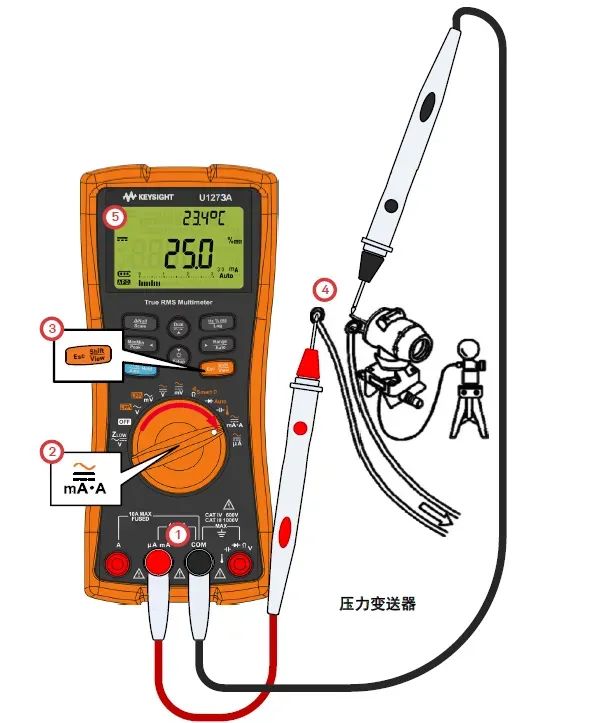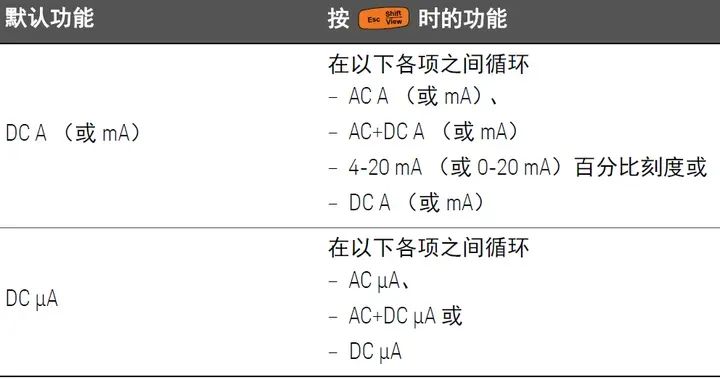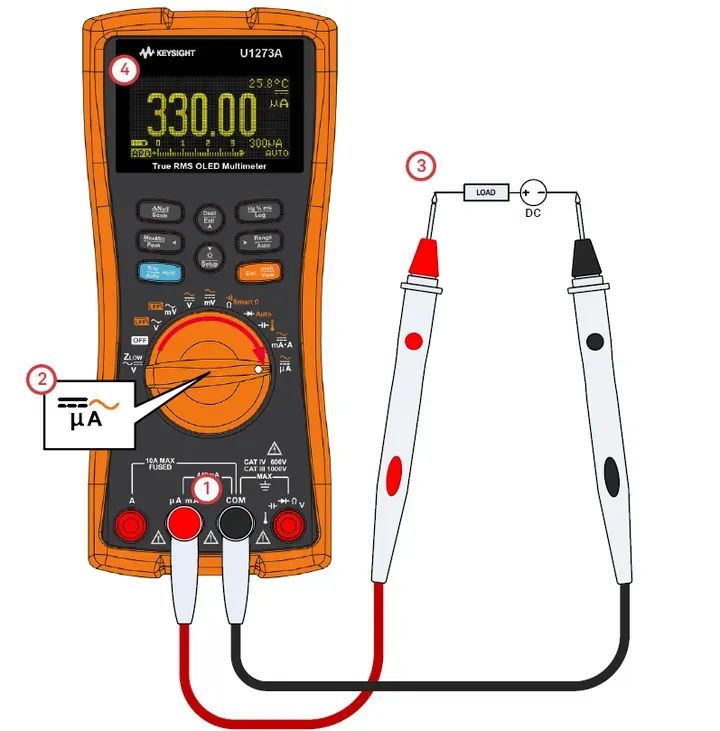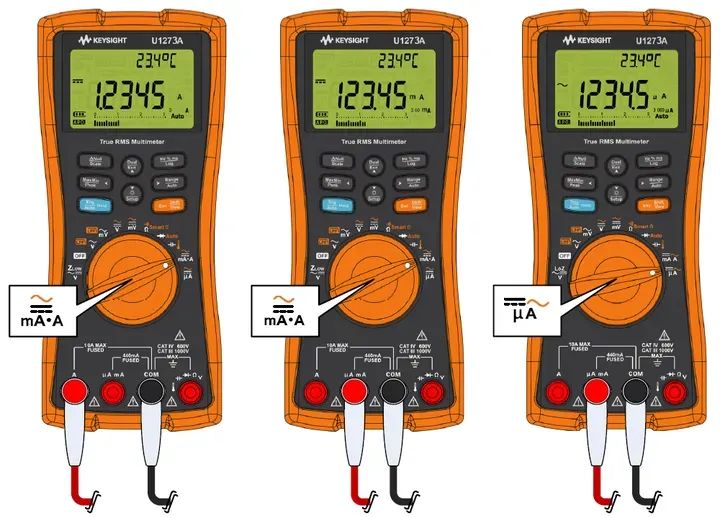Skip to content
A multimeter is an instrument that can measure various parameters, such as alternating current (AC) or direct current (DC) voltage, AC or DC current, resistance, temperature, capacitance, and more. Modern digital multimeters have adopted digital and logic technologies, becoming smaller in size and featuring more built-in functions. By introducing digital technology, digital multimeters can provide graphical displays, data logging, signal digitization, programming capabilities, and can also communicate with external devices.
Steps to Measure Current Using a Multimeter When measuring current with a multimeter, the multimeter is connected in series with the Device Under Test (DUT) circuit. The current flowing through the DUT is measured by the voltage drop across the internal resistance of the multimeter.
Note: If the DUT itself has a very low resistance, connecting the multimeter in series may alter the characteristics of the DUT circuit. How to Use a Multimeter to Measure AC or DC Current? Set the multimeter to measure AC or DC current, as shown in Figures 1 and 2. Disconnect the circuit path to be tested. Probe the test points and read the displayed values. Table 1 shows the rotary switch positions that allow current measurements.
Never attempt to measure current in a circuit when the open circuit potential exceeds 1000 V, as this could damage the multimeter and may result in electric shock or personal injury. To avoid damaging the multimeter or the device under test: – Check the multimeter’s fuse before measuring current. – Use the correct terminals, function, and range for measurement. – When the leads are inserted into the current terminals, never place the probes in a position that crosses (or parallels) any circuit or component. Note

 Figure DC Current Display – To avoid blowing the 440 mA fuse of the multimeter, only use the μA/mA terminals when you are sure the current is below 400 mA. Refer to Figure 2-34 for test lead connections and function selection. See the input warning section for information regarding the alerts used by the multimeter when leads are incorrectly used for current measurements. – When the leads are inserted into the current terminals, placing the probes in a position that crosses (or parallels) the powered circuit will damage the circuit being tested and blow the multimeter’s fuse. This is because the resistance through the multimeter’s current terminals is very low, causing a short circuit. – For information on measuring AC current signals with DC bias, refer to “Using Filters for DC Measurements”. – To measure DC current from composite signals in DC measurement mode, ensure the filter is enabled.
Figure 1 Measuring DC Current
Figure 2 Measuring AC Current
Figure 2-34 Current Measurement Settings 4-20 mA or 0-20 mA Percentage Scale Table 2 shows the rotary switch positions that allow current measurements.
Note: – The 4-20 mA current loop output from the transmitter is a type of electrical signal that is used in series circuits to provide a strong measurement signal proportional to pressure, temperature, or current applied in process control. This signal is a current loop where 4 mA represents a zero percent signal and 20 mA represents a one hundred percent signal. – The 4-20 mA or 0-20 mA percentage scale in this multimeter is calculated using the corresponding DC mA measurement. The multimeter will automatically optimize the best results for the selected measurement. The percentage scale has two available ranges, as shown in Table 2-19.
Figure 3 4-20 mA Percentage Scale Display Analog bar graph displaying the current measurement value. (In the example above, 24 mA is represented as 125% on the 4-20 mA percentage scale) Table 3 Percentage Scale Measurement Range
[a] Applicable for auto-ranging and manual range selection. The percentage scale range (4-20 mA or 0-20 mA) can be changed via the multimeter’s settings menu. The percentage scale can be used to measure pressure, temperature, current, pH, or other process variables for pressure transmitters, valve positioners, or other output actuators.
Figure 4 Measuring DC Current Using the 0-20 mA Percentage Scale
Source: Keysight Technologies
Figure DC Current Display – To avoid blowing the 440 mA fuse of the multimeter, only use the μA/mA terminals when you are sure the current is below 400 mA. Refer to Figure 2-34 for test lead connections and function selection. See the input warning section for information regarding the alerts used by the multimeter when leads are incorrectly used for current measurements. – When the leads are inserted into the current terminals, placing the probes in a position that crosses (or parallels) the powered circuit will damage the circuit being tested and blow the multimeter’s fuse. This is because the resistance through the multimeter’s current terminals is very low, causing a short circuit. – For information on measuring AC current signals with DC bias, refer to “Using Filters for DC Measurements”. – To measure DC current from composite signals in DC measurement mode, ensure the filter is enabled.
Figure 1 Measuring DC Current
Figure 2 Measuring AC Current
Figure 2-34 Current Measurement Settings 4-20 mA or 0-20 mA Percentage Scale Table 2 shows the rotary switch positions that allow current measurements.
Note: – The 4-20 mA current loop output from the transmitter is a type of electrical signal that is used in series circuits to provide a strong measurement signal proportional to pressure, temperature, or current applied in process control. This signal is a current loop where 4 mA represents a zero percent signal and 20 mA represents a one hundred percent signal. – The 4-20 mA or 0-20 mA percentage scale in this multimeter is calculated using the corresponding DC mA measurement. The multimeter will automatically optimize the best results for the selected measurement. The percentage scale has two available ranges, as shown in Table 2-19.
Figure 3 4-20 mA Percentage Scale Display Analog bar graph displaying the current measurement value. (In the example above, 24 mA is represented as 125% on the 4-20 mA percentage scale) Table 3 Percentage Scale Measurement Range
[a] Applicable for auto-ranging and manual range selection. The percentage scale range (4-20 mA or 0-20 mA) can be changed via the multimeter’s settings menu. The percentage scale can be used to measure pressure, temperature, current, pH, or other process variables for pressure transmitters, valve positioners, or other output actuators.
Figure 4 Measuring DC Current Using the 0-20 mA Percentage Scale
Source: Keysight Technologies























